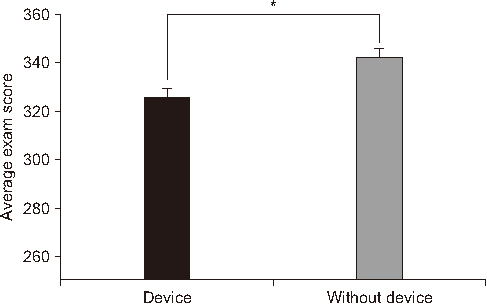Ewha Med J.
2019 Jan;42(1):1-5. 10.12771/emj.2019.42.1.1.
Growing Trend of Medical Students in Utilizing Electronic Devices for Studying
- Affiliations
-
- 1Ewha Womans University College of Medicine, Seoul, Korea.
- 2Department of Anatomy, Ewha Womans University College of Medicine, Seoul, Korea. sja@ewha.ac.kr
- KMID: 2433549
- DOI: http://doi.org/10.12771/emj.2019.42.1.1
Abstract
OBJECTIVES
There is a growing trend of medical students using electronic devices for studying. This paper analyzes such trend and assesses if the utilization of devices is adequate to effectively help students to study.
METHODS
Survey of total 155 medical students about the usage of the electronic devices for studying during the first year of medical school was done. The answers were matched with their exam scores in the first year.
RESULTS
Most of students were using a device, as a learning tool and the most important purpose of it was its convenience, especially for taking notes during lectures. However, students who didn't use a device when they learned anatomy or who studied with the printouts showed a tendency of receiving better scores on exams.
CONCLUSION
Utilizing electronic devices for studying tends to be more convenient, but not effective for studying anatomy.
Figure
Reference
-
1. Kwon N, Lee J, Chung E, Chang G, Yoon H. Comparative analyses of the uses of information and information technologies in the everyday life of undergraduate and graduate students majoring science and engineering. J Korean Soc Inf Manage. 2013; 30:269–295.
Article2. Lee J, Kim Y. Examining structural relationships among self-regulated learning, flow, satisfaction, and continuous intention to use smart learning. J Educ Res. 2015; 13:127–150.3. Ryan D. Using tablet technology for personalizing learning. J Res Spec Educ Needs. 2016; 16:1071–1077.4. Schwab K. The fourth industrial revolution. New York: Crown Business;2016.5. Chung JY. A study on the design of personal learning system preparing for the era of the fourth industrial revolution. Polit Educ. 2017; 24:53–72.6. Peverly ST, Vekaria PC, Reddington LA, Sumowski JF, Johnson KR, Ramsay CM. The relationship of handwriting speed, working memory, language comprehension and outlines to lecture note-taking and test-taking among college students. Appl Cogn Psychol. 2013; 27:115–126.
Article7. Bui DC, Myerson J, Hale S. Note-taking with computers: exploring alternative strategies for improved recall. J Educ Psychol. 2013; 105:299–309.
Article8. Stacy EM, Cain J. Note-taking and handouts in the digital age. Am J Pharm Educ. 2015; 79:107.
Article9. Mueller PA, Oppenheimer DM. The pen is mightier than the keyboard: advantages of longhand over laptop note taking. Psychol Sci. 2014; 25:1159–1168.10. Stephens A. The Benefits of hand-written versus digital notetaking in college lectures. Lexia: Undergraduate Journal in Writing, Rhetoric & Technical Communication. 2017.11. Joewono M, Karmaya IN, Wirata G, Yuliana , Widianti IGA, Wardana IN. Drawing method can improve musculoskeletal anatomy comprehension in medical faculty student. Anat Cell Biol. 2018; 51:14–18.
Article
- Full Text Links
- Actions
-
Cited
- CITED
-
- Close
- Share
- Similar articles
-
- Clinical Evaluation of the Accuracy of Electronic Home Blood Pressure Measuring Devices
- Medical Students' Perception and Satisfaction with Medical Communication Teaching Using Electronic Modules
- Augmented Reality Application to Develop a Learning Tool for Students: Transforming Cellphones into Flashcards
- Perspective on Wearable Devices for Cardiac Arrhythmia Detection
- Study on Middle and High School Students' Use of Convenience Foods at Convenience Stores in Incheon



